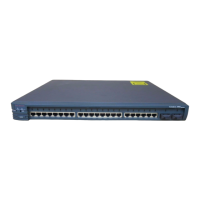Chapter 3: Supervisor Engine Configuration 47
Section 3-8
systems to view neighbor information. The command show cdp interface type
mod/port or show cdp port mod/port displays port-specific information about CDP.
Feature Example
This example shows a switch with the CDP timers altered so that the holdtime is 480 sec-
onds and the update time is 120 seconds. It also shows Fast Ethernet ports 1 to 12 on an
IOS switch:
Switch(config)# cdp timer 120
Switch(config)# cdp holdtime 480
Switch(config)# interface fastethernet 0/1
Switch(config)# no cdp enable
Switch(config)# interface fastethernet 0/2
Switch(config)# no cdp enable
Switch(config)# interface fastethernet 0/3
Switch(config)# no cdp enable
Switch(config)# interface fastethernet 0/4
Switch(config)# no cdp enable
Switch(config)# interface fastethernet 0/5
Switch(config)# no cdp enable
Switch(config)# interface fastethernet 0/6
Switch(config)# no cdp enable
Switch(config)# end
Switch# copy running-config startup-config
3-8: Time and Calendar
■ System time is maintained by the software. When a switch is initialized, the system
time is set from a hardware time clock (system calendar) in the switch.
■ An accurate system clock is important to maintain, especially when you need to
compare the output of logging and debugging features. A switch timestamps these
messages, giving you a frame of reference.
■ System time is maintained as coordinated universal time (UTC, also known as
Greenwich mean time, or GMT). The format of time as it is displayed can be config-
ured with operating system commands.
■ System time can be set manually or by Network Time Protocol (NTP). In addition,
the hardware time clock in a switch can be updated by NTP if desired.
■ NTP uses a concept of stratum to determine how close an NTP speaker is to an
authoritative time source (an atomic or radio clock). Stratum 1 means that an NTP
server is directly connected to an authoritative time source. NTP also compares the
times reported from all configured NTP peers and will not listen to a peer that has a
significantly different time.
